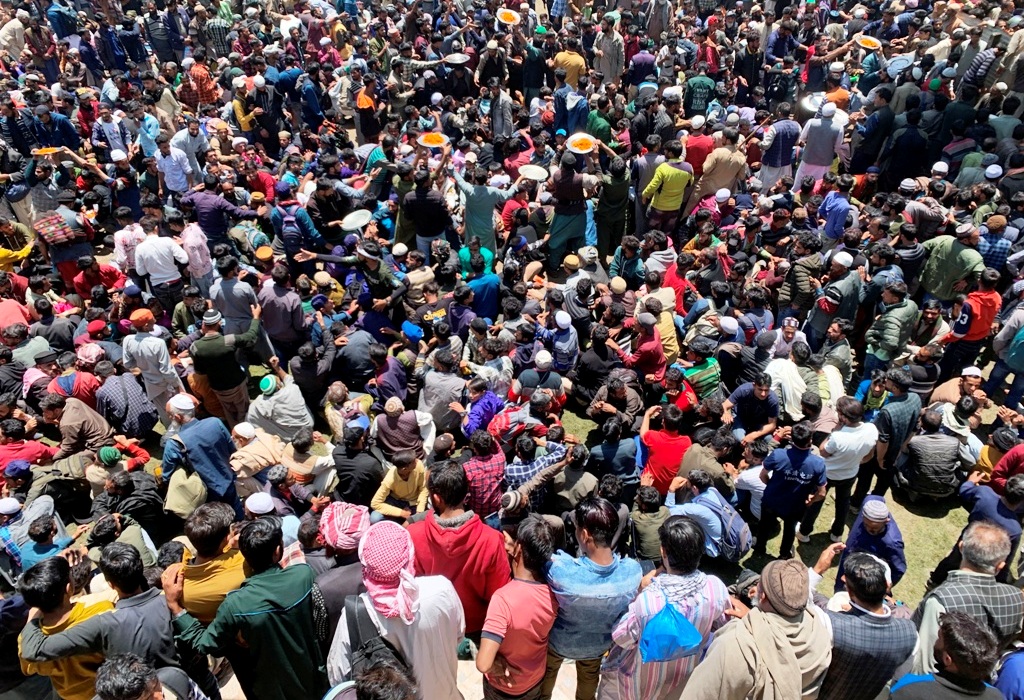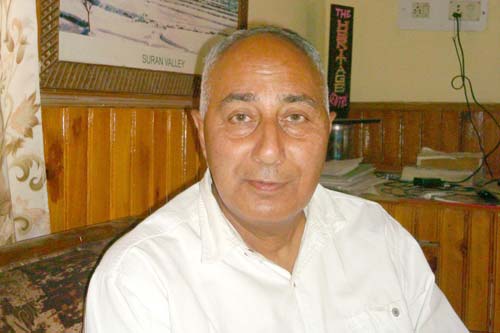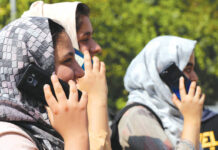by KD Maini
Aside from daily gatherings at the shrine, the Urs (death anniversary) of Baba Nazam-ud–Din Kayanvi, the Pir (spiritual teacher) of Baba Ji Sahib, is celebrated with great enthusiasm. Over one lakh devotees participate annually from across the erstwhile state.

Darbar Lar Shareef Baba Nagri, Wangat, located 45 km north of Srinagar, holds immense significance for the Gujjar-Bakarwal tribe and the Pahari-speaking people of Jammu and Kashmir. They share a profound spiritual connection with this Dargah. Every day, numerous tribal and Pahari families visit the shrine to pay their respects to Baba Ji Sahib, Haji Baba (Mian Nazam-ud-Din Larvi), and Baba Sahib (Mian Bashir Ahmed Larvi). They seek blessings from the current Sajjāda Nashīn (Head Priest), Mian Altaf Ahmed.
Mian Altaf Ahmed conducts daily religious and spiritual sessions for devotees, welcoming them with a warm smile and a compassionate demeanour. During these sessions, he imparts spiritual teachings that become cherished moments for the devotees. He patiently listens to their religious concerns and everyday problems, offering advice for their social upliftment and guidance for a brighter future.
The impact of these routine sessions is profound, shaping the lives of the tribal community. Darbar Lar is revered as a symbol of pride, heritage, and culture – a spiritual stronghold for the Gujjar-Bakarwal tribes and Pahari people.
After receiving blessings from Sajjāda Nashīn, devotees head to the Langer Hall (community kitchen) for a meal. Typically, they are served Makki Ki Roti (Maize Flour Flatbread/Gogi), Lassi (yoghurt beverage), and chutney as Tabarruk (blessing), in addition to a regular meal. Following the meal, devotees proceed to the mosque for prayer. Afterwards, tribal members may either return home with spiritual comfort or stay in the guest house.
Aside from daily gatherings at the shrine, the Urs (death anniversary) of Baba Nazam-ud-Din Kayanvi, the Pir (spiritual teacher) of Baba Ji Sahib, is celebrated with great enthusiasm. Over one lakh devotees participate annually from across the erstwhile state. During this event, tribal families have the chance to reconnect, share their experiences, and seek guidance from Sajjāda Nashīn on religious practices, facing daily challenges, and securing a better future for the new generation.
Darbar Lar Baba Nagri was founded in 1893 when the revered spiritual saint Baba Ji Sahib, guided by his Pir Baba Nazum-ud-Din Kayanvi, moved from his native village Sanjora Balakote (now in Pakistan) to Hari Dhaji, Wangat. Accompanied by some tribal families, Baba Sahib settled in Wangat after the locals were impressed by his spirituality.
With the support of the community, Baba Sahib built a house, acquired cultivable land in Hari Dhaji, and initiated the practice of serving Langer. As word spread about this spiritual saint, people began visiting to seek blessings from Baba Sahib. In addition to his religious teachings, he was a spiritual figure, Sufi poet, and social reformer of his time. He authored three books: Israr-e-Kabiri, Malfuzat-a-Nazamia, and Baba Ji Sahib ki Si Harfian.

In a short period, he gained popularity in Kashmir, Poonch and Rajouri. Baba Sahib also established a winter Darbar at Mohra Poonch for the convenience of devotees. According to the renowned historian Mohammad Din Fouq, in his book Tariq-E-Aqwam-e-Poonch, almost all Gujjar-Bakarwals and Pahari-speaking people in Poonch Rajouri and the upper reaches of Pir Panchal in Kashmir became followers of Baba Sahib. He passed away at the age of 63 in 1926 in Wangat and was buried at the present Darbar Lar Ziyarat.
Following Baba Sahib’s passing, his son Mian Nazum-ud-Din Larvi took on the role of Sajjāda Nashīn at the Shrine. Beyond being a religious preacher and social reformer, he also emerged as a political leader for the Gujjar-Bakarwal tribes and Pahari people. Committed to uplifting the suppressed Gujjar-Bakarwals community, he established the Gujjar Jat Conference in 1933 to offer political guidance to his followers.
By 1946, before the events of 1947, Nazum-ud-Din Larvi became a member of the of the Parjya Sabha. Despite the challenges following the turmoil in 1947, he continued serving as an MLA from 1953 to 1967, providing both religious and political leadership to his devotees. Mian Nazum-ud-Din Larvi passed away in 1972 and was laid to rest near the grave of Baba Ji Sahab in Darbar.
After Nazam-ud–Din Larvi’s passing in 1972, his elder son Mian Bashir Ahmed took on the role of Sajjāda Nashīn at the Darbar. Mian Bashir Ahmed, a renowned orator, reformer, and spiritual figure, was also a people-friendly political leader. He served as an MLA from 1967 to 1987 and held ministerial positions in the governments of Sadiq, Mir Qasim, and Sheikh Abdullah.
Despite his political engagements, Mian Bashir Ahmed dedicated his life to serving the downtrodden. In 2008, he received the Padma Shri award from the Government of India in recognition of his spiritual contributions. Throughout his life, he championed the betterment of the Gujjar-Bakarwal community. Notably, he maintained a strong relationship with Indira Gandhi, who sanctioned Rs 13 crore in 1974 for the welfare of the community at Baba Sahib’s request. In 1980, he resigned from Sheikh Abdullah’s cabinet over the issue of Schedule Tribe status for the Gujjar-Bakarwal Tribes. Although Mrs Gandhi assured the declaration of Schedule Tribe status, it faced delays after her assassination in 1984.
In 1991, Gujjar–Bakarwal delegations met Prime Minister Chander Shekhar, pressing for the approval of Schedule Tribe status. As the process was already underway, Chander Shekhar announced the Schedule Tribe status for the Gujjar-Bakarwal tribes in 1991.
After 1987, Mian Bashir Ahmed left politics to focus on religious and spiritual teachings, dedicating himself to serving the downtrodden tribes. In 2018, due to health issues, he appointed his son Altaf Ahmed as the Sajjāda Nashīn of Darbar Lar.
As a minister, MLA, and later a preacher, Mian Bashir Ahmed lived among the Gujjar-Bakarwal tribes and Pahari people. He stayed in their huts, ate, dressed, and lived like them, spoke their language, and preached in a way they could relate to. He was recognised as a saint with spiritual deeds and considered the Wali of Kashmir. He passed away on August 14, 2021, and was buried in Darbar Lar near his father’s grave.

The current Sajjāda Nashīn, Mian Altaf Ahmed, born in Baba Nagri in 1958, received primary education from Primary School Wangat. He later attended DAV College Srinagar, graduated from Amar Singh College, and obtained an LLB from Kashmir University. Despite opportunities in government service or private practice, he chose to serve the Gujjar-Bakarwal community, having witnessed their challenging conditions since childhood.
Mian Altaf Ahmed entered politics, winning on a Congress ticket in 1987 from Kangan and serving as a minister until January 19, 1990, in Farooq Abdullah’s government. From 1990 to 1996, he focused on shrine matters and assisted victims of militancy. Re-elected in 1996, he served as an MLA and health minister in Farooq’s government. In the 2007 election, he won from Kangan and became the forest minister in Omar Abdullah’s government. Since 2018, he has overseen the matters of Darbar Lar, maintaining a traditional connection with followers on both sides of the Pir Panchal region. The Gujjar-Bakarwal tribes and Pahari-speaking people consider Darbar Lar a religious and spiritual stronghold.
(A former officer, the author is a respected historian from Pir Panchal Valley. The ideas are personal.)














